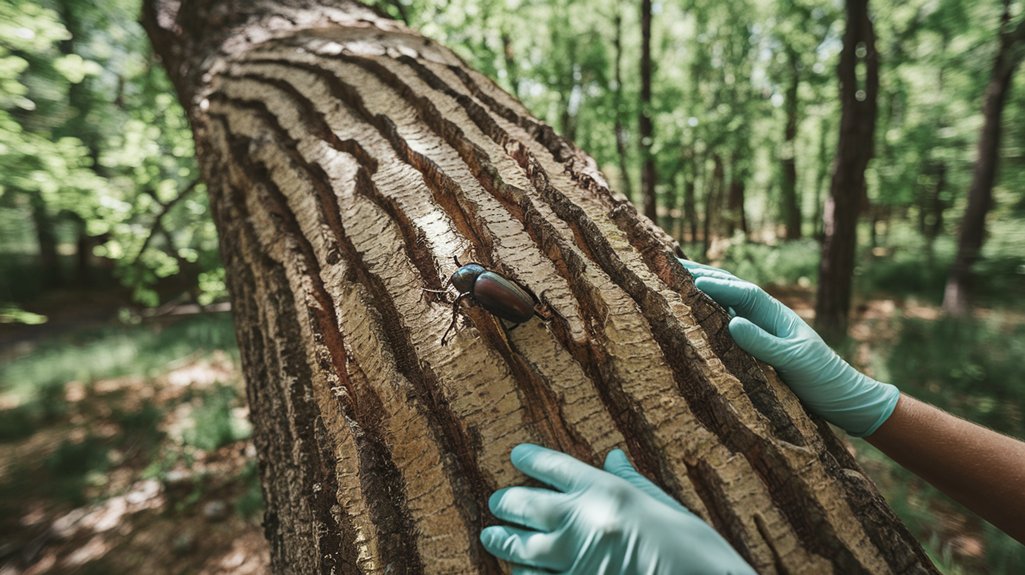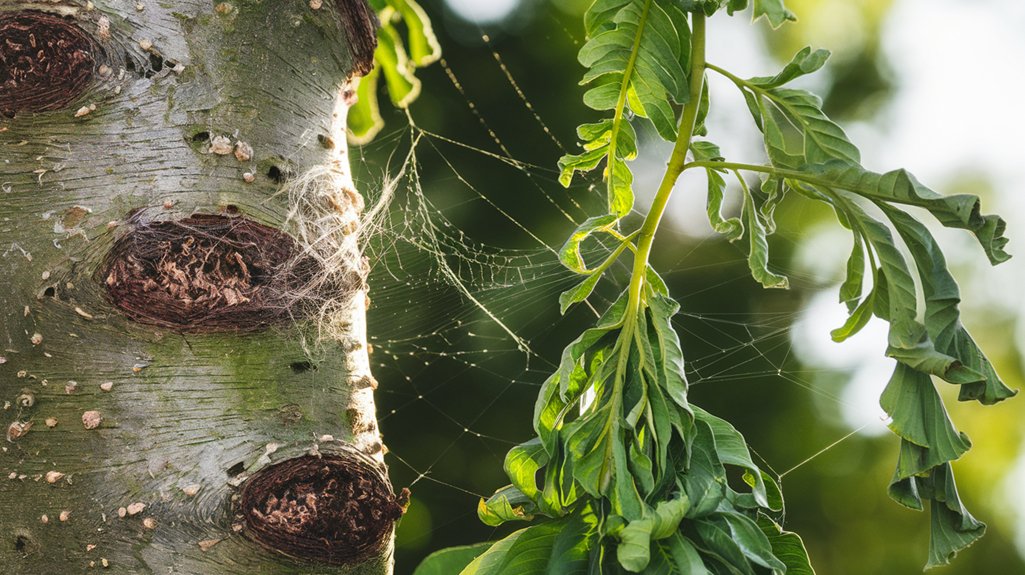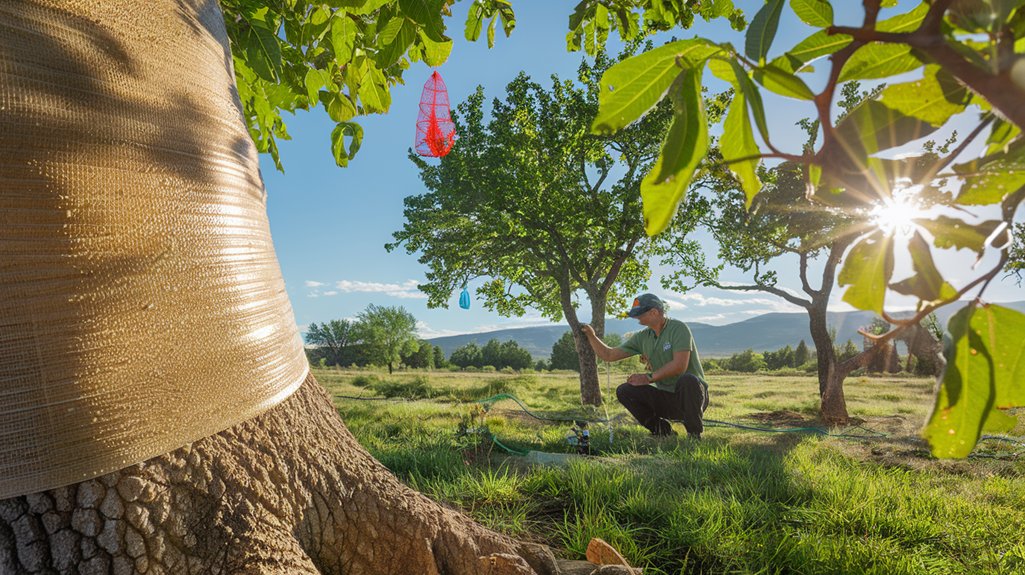Protecting your trees from Colorado's destructive pests is crucial for their health and longevity. You need to stay vigilant against threats like the spruce bark beetle and emerald ash borer. Regular monitoring can help you catch early signs of infestation. But what about the steps you can take to ensure your trees remain strong and resilient? Let's explore the essential strategies that can keep your trees thriving in this challenging environment.
Key Takeaways
- Regularly monitor trees for signs of pests, such as discolored leaves, boreholes, or wilting, to catch infestations early.
- Maintain tree health through proper nutrition, soil testing, and organic matter addition to enhance resilience against pests.
- Prune dead branches to improve airflow, reducing the risk of disease and pest infestations.
- Utilize eco-friendly solutions like neem oil and companion planting to deter harmful insects naturally.
- Apply chemical treatments only when necessary, following label instructions and considering timing for maximum effectiveness.
Understanding the Threat: Common Pests in Colorado

As you explore the beauty of Colorado's landscapes, it's crucial to be aware of the common pests that threaten your trees. Various tree species are vulnerable to these invaders, each facing unique challenges.
For instance, the spruce bark beetle targets spruce trees, while the emerald ash borer wreaks havoc on ash species. Understanding the pest lifecycle is vital; many pests thrive during specific seasons, making timely intervention essential.
Early detection can prevent significant damage, so familiarize yourself with the life stages of these pests. By recognizing their patterns, you can better protect your trees and maintain the health of your landscape.
Stay vigilant and informed to ensure your trees remain vibrant and resilient against these persistent threats.
Identifying Signs of Infestation

How can you tell if your trees are dealing with a pest infestation? Identifying infestation symptoms early can save your trees.
Look out for these signs:
- Discolored Leaves: Yellowing or browning leaves may indicate stress from pests feeding on your tree.
- Boreholes or Sawdust: Tiny holes in the trunk or branches, along with sawdust, often point to wood-boring pests.
- Wilting or Dropping Leaves: If your tree's leaves are wilting or falling prematurely, it could signal pest activity.
Keep an eye on these signs for effective pest identification.
Early detection is key to maintaining the health of your trees and preventing further damage from destructive pests.
Preventative Measures for Tree Health

To keep your trees healthy and resilient against pests, implementing preventative measures is essential. Start by ensuring proper tree nutrition; provide the right balance of nutrients to support growth and immunity.
Regularly test your soil health to determine if it meets the needs of your trees. Adding organic matter can enhance soil structure and promote beneficial microorganisms.
Mulching around the base of your trees helps retain moisture and suppress weeds, making it easier for roots to thrive.
Prune dead or unhealthy branches to improve airflow and reduce disease risk. Water your trees adequately, especially during dry spells, to maintain their strength.
Chemical Treatments: When and How to Use Them
While maintaining a healthy tree environment is crucial, there are times when chemical treatments become necessary to combat severe pest infestations.
If you find yourself in this situation, here's how to approach pesticide application effectively:
- Identify the Pests: Understand which pests are affecting your trees. Accurate identification helps in choosing the right pesticide.
- Develop a Treatment Schedule: Timing is key. Apply pesticides during the pests' active season for maximum effectiveness.
- Follow Label Instructions: Always read and adhere to the pesticide label to ensure safe and effective application.
Natural Remedies and Eco-Friendly Solutions
Chemical treatments can be effective against severe pest infestations, but many tree owners prefer natural remedies and eco-friendly solutions to protect their trees.
One effective method is companion planting, where you grow specific plants alongside your trees to deter pests naturally. For instance, planting marigolds can help repel harmful insects, creating a healthier environment for your trees.
Another popular option is neem oil, derived from the seeds of the neem tree. It's a potent natural pesticide that disrupts the life cycle of pests without harming beneficial insects.
Regular Maintenance and Monitoring Practices
Regular maintenance and monitoring practices are essential for keeping your trees healthy and pest-free. By staying proactive, you can effectively prevent pest infestations and ensure optimal growth.
Here are three key practices to incorporate:
- Tree Pruning: Regularly prune your trees to remove dead or diseased branches. This not only improves air circulation but also reduces pest habitats.
- Soil Health: Test your soil regularly and amend it as needed. Healthy soil supports robust root systems, making trees more resilient to pests.
- Routine Inspections: Walk around your trees at least once a month. Look for signs of pests or disease, such as discolored leaves or unusual growths.
Frequently Asked Questions
How Can I Tell if My Tree Is Stressed?
To tell if your tree's stressed, look for stress indicators like wilting leaves, discolored foliage, or premature leaf drop. Regularly check your tree health, and address any issues promptly to ensure its vitality and longevity.
What Time of Year Is Best for Tree Treatments?
The best time for tree treatments is spring for proactive care and fall for addressing any issues. You'll promote healthy growth and prepare your trees for winter by timing your treatments effectively with seasonal changes.
Are All Tree Species Equally Susceptible to Pests?
Not all tree species are equally susceptible to pests. Some demonstrate pest resistance while others show higher species vulnerability. Knowing which trees thrive in your area can help you manage pest issues effectively.
Can I Treat Multiple Trees at Once?
Yes, you can treat multiple trees at once. Use effective tree treatment methods and pest prevention strategies to cover all trees thoroughly. Just ensure each tree receives the appropriate care based on its specific needs.
How Do Weather Conditions Affect Pest Activity?
Weather conditions greatly influence pest activity. Temperature fluctuations and seasonal patterns can trigger pests to emerge earlier or later, affecting their lifecycle and behavior, so you should monitor these changes to manage potential infestations effectively.
Conclusion
By staying vigilant and proactive, you can protect your trees from Colorado's destructive pests. Regularly monitor for signs of infestation and implement preventative measures to keep your trees healthy. When necessary, don't hesitate to use chemical treatments or explore natural remedies to combat pests. Remember, maintaining your trees with proper care and attention will not only enhance their resilience but also contribute to a thriving ecosystem. Keep your trees safe and flourishing for years to come!
